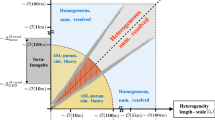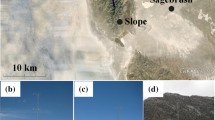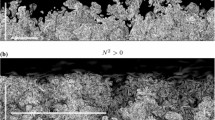Abstract
We investigate the effects of condensation and liquid water loading on the stably stratified surface layer, with an eye towards understanding the influence of turbulent mixing on fog formation. Direct numerical simulations of dry and moist open-channel flows are conducted, where in both a constant cooling rate is applied at the ground to mimic longwave radiative cooling. Depending on the cooling rate, this can lead to either turbulent (weakly stable) or laminar (very stable) flows. Compared to the completely dry case, the condensation of liquid water in the moist case enables slightly higher cooling rates to be achieved before leading to turbulence collapse. In the very stable cases, runaway cooling leads to the substantial condensation of liquid water close to the ground and fog (visibility less than 1 km) results over much of the domain. In the weakly stable cases, turbulent mixing narrowly yields visibilities of 1 km close to the ground over a similar time period. However, despite the idealized nature of the system, the present results suggest that turbulence impedes, although will not necessarily inhibit, fog formation. A possible mechanism for fog formation within turbulent flows is identified, wherein regions of increased liquid water content form within the low-speed streaks of the near-wall cycle. These streaks are energized in the moist cases due to reduced dissipation of turbulence kinetic energy compared to the dry case, although in both cases the streaks are less energetic and persistent than in neutrally-stratified flow.











Similar content being viewed by others
References
Adrian RJ, Meinhart CD, Tomkins CD (2000) Vortex organization in the outer region of the turbulent boundary layer. J Fluid Mech 422:1–54
Andrejczuk M, Grabowski WW, Malinowski SP, Smolarkiewicz PK (2004) Numerical simulation of cloud-clear air interfacial mixing. J Atmos Sci 61:1726–1739
Andrejczuk M, Grabowski WW, Malinowski SP, Smolarkiewicz PK (2006) Numerical simulation of cloud-clear air interfacial mixing: effects on cloud microphysics. J Atmos Sci 63:3204–3225
Andrejczuk M, Grabowski WW, Malinowski SP, Smolarkiewicz PK (2009) Numerical simulation of cloud-clear air interfacial mixing: homogeneous versus inhomogeneous mixing. J Atmos Sci 66:2493–2500
Ansorge C, Mellado JP (2014) Global intermittency and collapsing turbulence in the stratified planetary boundary layer. Boundary-Layer Meteorol 153:89–116
Barkstrom BR (1978) Some effects of 8–12 \(\mu \)m radiant energy transfer on the mass and heat budgets of cloud droplets. J Atmos Sci 35:665–673
Bergot T (2013) Small-scale structure of radiation fog: a large-eddy simulation study. Q J R Meteorol Soc 139:1099–1112
Bergot T (2016) Large-eddy simulation study of the dissipation of radiation fog. Q J R Meteorol Soc 142:1029–1040
Bott A, Sievers U, Zdunkowski W (1990) A radiation fog model with a detailed treatment of the interaction between radiative transfer and fog microphysics. J Atmos Sci 47:2153–2166
Bou-Zeid E, Higgins C, Huwald H, Meneveau C, Parlange MB (2010) Field study of the dynamics and modelling of subgrid-scale turbulence in a stable atmospheric surface layer over a glacier. J Fluid Mech 665:480–515
Brown R, Roach WT (1976) The physics of radiation fog: II-a numerical study. Q J R Meteorol Soc 102:335–354
Businger JA (1982) The fluxes of specific enthalpy, sensible heat and latent heat near the Earth’s surface. J Atmos Sci 39:1889–1892
Chung D, Matheou G (2014) Large-eddy simulation of stratified turbulence. Part I: a vortex-based subgrid-scale model. J Atmos Sci 71:1863–1879
Cossu C, Hwang Y (2017) Self-sustaining processes at all scales in wall-bounded turbulent shear flows. Phil Trans R Soc A 375(20160):088
de Lozar A, Mellado JP (2015) Mixing driven by radiative and evaporative cooling at the stratocumulus top. J Atmos Sci 72:4681–4700
de Lozar A, Mellado JP (2017) Reduction of the entrainment velocity by cloud droplet sedimentation in stratocumulus. J Atmos Sci 74:751–765
de Roode SR, Jonker HJJ, van de Wiel BJH, Vertregt V, Perrin V (2017) A diagnosis of excessive mixing in Smagorinsky subfilter-scale turbulent kinetic energy models. J Atmos Sci 74:1495–1511
Deardorff JW (1980) Stratocumulus-capped mixed layers derived from a three-dimensional model. Boundary-Layer Meteorol 18:495–527
Duynkerke PG (1999) Turbulence, radiation and fog in Dutch stable boundary layers. Boundary-Layer Meteorol 90:447–477
Elliott WP (1958) The growth of the atmospheric internal boundary layer. Trans Am Geophys Union 39:1048–1054
Flores O, Jiménez J (2010) Hierarchy of minimal flow units in the logarithmic layer. Phys Fluids 22(071):704
Flores O, Riley JJ (2011) Analysis of turbulence collapse in the stably stratified surface layer using direct numerical simulation. Boundary-Layer Meteorol 139:241–259
Flores O, Riley JJ (2018) Energy balance in stably-stratified, wall-bounded turbulence. In: van Heijst GJF, Clercx HJH (eds) Mixing and dispersion in flows dominated by rotation and buoyancy. Springer, New York, pp 89–99
Gage KS, Reid WH (1968) The stability of thermally stratified plane Poiseuille flow. J Fluid Mech 33:21–32
García-Villalba M, del Álamo JC (2011) Turbulence modification by stable stratification in channel flow. Phys Fluids 23(045):104
Gohari SMI, Sarkar S (2017) Direct numerical simulation of turbulence collapse and rebirth in stably stratified Ekman flow. Boundary-Layer Meteorol 162:401–426
Grabowski WW, Smolarkiewicz PK (1990) Monotone finite-difference approximations to the advection-condensation problem. Mon Weather Rev 118:2082–2098
Grabowski WW, Smolarkiewicz PK (2002) A multiscale anelastic model for meteorological research. Mon Weather Rev 130:939–956
Gultepe I, Tardif R, Michaelides SC, Cermak J, Bott A, Bendix J, Müller MD, Pagowski M, Hansen B, Ellrod G, Jacobs W, Toth G, Cober SG (2007) Fog research: a review of past achievements and future perspectives. Pure Appl Geophys 164:1121–1159
Hamilton JM, Kim J, Waleffe F (1995) Regeneration mechanisms of near-wall turbulence structures. J Fluid Mech 287:317–348
Hwang Y (2015) Statistical structure of self-sustaining attached eddies in turbulent channel flow. J Fluid Mech 767:254–289
Hwang Y, Bengana Y (2016) Self-sustaining process of minimal attached eddies in turbulent channel flow. J Fluid Mech 795:708–738
Izett JG, Schilperoort B, Coenders AMJ, Baas P, Bosveld FC, van de Wiel BJH (2019) Missed fog?: On the potential of obtaining observations at increased resolution during shallow fog events. Boundary-Layer Meteorol. https://doi.org/10.1007/s10546-019-00462-3
Jacobitz FG, Sarkar S, Van Atta CW (1997) Direct numerical simulations of the turbulence evolution in a uniformly sheared and stably stratified flow. J Fluid Mech 342:231–261
Jeong J, Hussain F, Schoppa W, Kim J (1997) Coherent structures near the wall in a turbulent channel flow. J Fluid Mech 332:185–214
Jiménez J (2018) Coherent structures in wall-bounded turbulence. J Fluid Mech 842:P1
Jiménez J, Pinelli A (1999) The autonomous cycle of near-wall turbulence. J Fluid Mech 389:335–359
Kim J, Moin P, Moser R (1987) Turbulence statistics in fully developed channel flow at low Reynolds number. J Fluid Mech 177:133–166
Kline SJ, Reynolds WC, Schraub FA, Runstadler PW (1967) The structure of turbulent boundary layers. J Fluid Mech 30:741–773
Kozul M, Chung D, Monty JP (2016) Direct numerical simulation of the incompressible temporally developing turbulent boundary layer. J Fluid Mech 796:437–472
Kunkel BA (1984) Parameterization of droplet terminal velocity and extinction coefficient in fog models. J Clim Appl Meteorol 23:34–41
Kurowski MJ, Grabowski WW, Smolarkiewicz PK (2014) Anelastic and compressible simulation of moist deep convection. J Atmos Sci 71:3767–3787
Lam K, Banerjee S (1992) On the condition of streak formation in a bounded turbulent flow. Phys Fluids 4:306–320
Lee J, Lee C (2015) Modification of particle-laden near-wall turbulence: effect of Stokes number. Phys Fluids 27(023):303
Lilly DK (1962) On the numerical simulation of buoyant convection. Tellus 14:148–172
Lozano-Durán A, Jiménez J (2014) Effect of the computational domain on direct simulations of turbulent channels up to \({R}e_\tau \)= 4200. Phys Fluids 26(011):702
MacDonald M, Chung D, Hutchins N, Chan L, Ooi A, García-Mayoral R (2017) The minimal-span channel for rough-wall turbulent flows. J Fluid Mech 816:5–42
Mahrt L (1999) Stratified atmospheric boundary layers. Boundary-Layer Meteorol 90:375–396
Mahrt L (2014) Stably stratified atmospheric boundary layers. Annu Rev Fluid Mech 46:23–45
Maronga B, Bosveld FC (2017) Key parameters for the life cycle of nocturnal radiation fog: a comprehensive large-eddy simulation study. Q J R Meteorol Soc 143:2463–2480
Marusic I, Heuer WDC (2007) Reynolds number invariance of the structure inclination angle in wall turbulence. Phys Rev Lett 99(114):504
Mazoyer M, Lac C, Thouron O, Bergot T, Massonv V, Musson-Genon L (2017) Large eddy simulation of radiation fog: impact of dynamics on the fog life cycle. Atmos Chem Phys 17:13,017–13,035
Mellado JP (2010) The evaporatively driven cloud-top mixing layer. J Fluid Mech 660:5–36
Mellado JP (2012) Direct numerical simulation of free convection over a heated plate. J Fluid Mech 712:418–450
Mellado JP, Stevens B, Schmidt H, Peters N (2010) Two-fluid formulation of the cloud-top mixing layer for direct numerical simulation. Theor Comput Fluid Dyn 24:511–536
Mellado JP, Stevens B, Schmidt H (2014) Wind shear and buoyancy reversal at the top of stratocumulus. J Atmos Sci 71:1040–1057
Moeng CH (1984) A large-eddy-simulation model for the study of planetary boundary-layer turbulence. J Atmos Sci 41:2052–2062
Moin P, Kim J (1982) Numerical investigation of turbulent channel flow. J Fluid Mech 118:341–377
Moin P, Mahesh K (1998) Direct numerical simulation: a tool in turbulence research. Annu Rev Fluid Mech 30(1):539–578
Monin AS (1970) The atmospheric boundary layer. Annu Rev Fluid Mech 2:225–250
Moser RD, Kim J, Mansour NN (1999) Direct numerical simulation of turbulent channel flow up to \({R}e_\tau = 590\). Phys Fluids 11:943–945
Munters W, Meneveau C, Meyers J (2016) Shifted periodic boundary conditions for simulations of wall-bounded turbulent flows. Phys Fluids 28(025):112
Nakanishi M (2000) Large-eddy simulation of radiation fog. Boundary-Layer Meterol 94:461–493
Nieuwstadt FTM (2005) Direct numerical simulation of stable channel flow at large stability. Boundary-Layer Meteorol 116:277–299
NOAA (2017) Federal Meteorological Handbook No. 1, Surface Weather Observations and Reports. US Department of Commerce/NOAA, Tech Rep FCM-H1-2017
Oliver DA, Lewellen WS, Williamson GG (1978) The interaction between turbulent and radiative transport in the development of fog and low-level stratus. J Atmos Sci 35:301–316
Pan Y, Banerjee S (1996) Numerical simulation of particle interactions with wall turbulence. Phys Fluids 8:2733–2755
Panofsky HA, Townsend AA (1964) Change of terrain roughness and the wind profile. Q J R Meteorol Soc 90:147–155
Porson A, Price J, Lock A, Clark P (2011) Radiation fog. Part II: large-eddy simulations in very stable conditions. Boundary-Layer Meteorol 139:193–224
Price J (2011) Radiation fog. Part I: observations of stability and drop size distributions. Boundary-Layer Meteorol 139:167–191
Price JD, Clark R (2014) On the measurement of dewfall and fog-droplet deposition. Boundary-Layer Meteorol 152:367–393
Prusa JM, Smolarkiewicz PK, Wyszogrodzki AA (2008) EULAG, a computational model for multiscale flows. Comput Fluids 37:1193–1207
Rashidi M, Hetsroni G, Banerjee S (1990) Particle-turbulence interaction in a boundary layer. Int J Multiph Flow 16:935–949
Roach WT (1976) On the effect of radiative exchange on the growth by condensation of a cloud or fog droplet. Q J R Meteorol Soc 102:361–372
Roach WT, Brown R, Caughey SJ, Garland JA, Readings CJ (1976) The physics of radiation fog: I-a field study. Q J R Meteorol Soc 102:313–333
Rodhe B (1962) The effect of turbulence on fog formation. Tellus 14:49–86
Schoppa W, Hussain F (2002) Coherent structure generation in near-wall turbulence. J Fluid Mech 453:57–108
Shah SK, Bou-Zeid E (2014) Direct numerical simulations of turbulent Ekman layers with increasing static stability: modifications to the bulk structure and second-order statistics. J Fluid Mech 760:494–539
Smolarkiewicz PK, Margolin LG (1997) On forward-in-time differencing for fluids: an Eulerian/semi-Lagrangian non-hydrostatic model for stratified flows. Atmos-Ocean 35:127–152
Smolarkiewicz PK, Margolin LG (1998) MPDATA: a finite-difference solver for geophysical flows. J Comput Phys 140:459–480
Soldati A, Marchioli C (2009) Physics and modelling of turbulent particle deposition and entrainment: review of a systematic study. Int J Multiph Flow 35:827–839
Steeneveld GJ, Ronda RJ, Holtslag AAM (2015) The challenge of forecasting the onset and development of radiation fog using mesoscale atmospheric models. Boundary-Layer Meteorol 154:265–289
Stull RB (1988) An introduction to boundary layer meteorology. Kluwer Academic Publishers, Berlin
Taylor GI (1917) The formation of fog and mist. Q J R Meteorol Soc 43:241–268
Teixeira J (1999) Simulation of fog with the ECMWF prognostic cloud scheme. Q J R Meteorol Soc 125:529–552
Welch RM, Ravichandran MG, Cox SK (1986) Prediction of quasi-periodic oscillations in radiation fogs. Part I: comparison of simple similarity approaches. J Atmos Sci 43:633–651
Van de Wiel BJH, Moene AF, Steeneveld GJ, Hartogensis OK, Holtslag AAM (2007) Predicting the collapse of turbulence in stably stratified boundary layers. Flow Turbul Combust 79:251–274
Acknowledgements
This research was carried out at the Jet Propulsion Laboratory, California Institute of Technology, under a contract with the National Aeronautics and Space Administration. Parts of this research were supported by the U.S. Department of Energy, Office of Biological and Environmental Research, Earth System Modeling; the NASA MAP Program; the Office of Naval Research, Marine Meteorology Program and the NOAA/CPO MAPP Program. We thank the three anonymous reviewers for their constructive comments on the manuscript. The authors also acknowledge the Texas Advanced Computing Center (TACC) at The University of Texas at Austin for providing HPC resources that have contributed to the research results reported within this paper.
Author information
Authors and Affiliations
Corresponding author
Additional information
Publisher's Note
Springer Nature remains neutral with regard to jurisdictional claims in published maps and institutional affiliations.
Appendices
Appendix 1: Effect of Computational Domain Size
In the present study, the domain size in the streamwise and spanwise directions is \(2\uppi {h}\times \uppi {h}\), which is standard for neutrally-stratified dry simulations (Lozano-Durán and Jiménez 2014; Munters et al. 2016). However, there can exist patches of laminar and turbulent flow in stably-stratified flows close to laminarization, which are of size 10h (that is, the present domain size). A small computational domain can therefore result in turbulent structures that get ‘locked’ in place due to the periodic boundary conditions (Flores and Riley 2011; García-Villalba and del Álamo 2011). This can require substantial time for the turbulence to repopulate the domain and does not represent a physically realistic scenario.
We double the domain size to \(4\uppi {h}\times 2\uppi {h}\) in the streamwise and spanwise directions, with the results shown in Fig. 12 for cooling with \(h/L=0.6\) and \(Re_\star =395\). We see a similar behaviour for both dry (solid) and moist (dashed) cases compared to the regular domain size. The peak around \(tU_\star /h\approx 10\) for the dry case temperature fluctuations (Fig. 12b) is due to the turbulence becoming locked in place. Visual inspection of the velocity field of the dry case (not shown) reveals a similar pattern to Fig. 5 of Flores and Riley (2011), in which there exist stripes of turbulent and laminar flow extending down the entire streamwise length of the domain. The present larger domain dry case also exhibits this effect, where García-Villalba and del Álamo (2011) notes domains of at least \(8\uppi {h}\times 3\uppi {h}\) are required to observe intermittency in the streamwise direction for statistically steady flows. This behaviour is not observed in any of the moist case, as presumably the mixing induced by condensation is sufficient to completely avoid these large laminar patches at these cooling rates. In this work, as in Flores and Riley (2011), we ignore data from when the turbulent flow is locked in place, as it is artificial. This is primarily of concern for the dry cases, and was not observed for the moist cases.
Time series of a r.m.s. vertical velocity fluctuations, and b temperature fluctuations at \(z^+=15\). Line styles are: red, \(h/L=0.6\) with \(T_0=279\hbox { K}\) (base case); grey, base case except with enlarged domain; blue, base case except with \(T_0=285\hbox { K}\). Solid lines denote dry cases, dashed denote moist cases
Same as Fig. 6b, showing time series of the height where \(\langle q_l\rangle \) is equal to a specified threshold, \(q_{l,t}\): dotted, \(q_{l,t}=5\times 10^{-6}\); dashed, \(q_{l,t}=1\times 10^{-6}\); and solid, \(q_{l,t}=10^{-8}\) (saturation interface) \(\hbox {kg kg}^{-1}\), for the weakly stable case 395M06 with \(h/L=0.6\). Line colours: red, \(T_0=279\hbox { K}\) (base case); grey, \(T_0 = 285\hbox { K}\)
Appendix 2: Effect of Initial Temperature
Given that the liquid water mixing ratio depends non-linearly on temperature, we also investigate the effect of the temperature at which the simulations are initialized, \(T_0\). For the cases studied herein, we set \(T_0=279.15\hbox { K}\), while here we increase the initial temperature to 285.15 K, for matched cooling rates of \(h/L=0.6\). Figure 13 shows the time series of fog height, as in Fig. 6b for these two initial temperatures. The two cases are initially similar although they start to diverge after approximately \(tU_\star /h\gtrsim 15\), at which point the interface between saturated and unsaturated water has reached the top boundary. The vertical velocity and temperature fluctuations shown in Fig. 12 also show good agreement between the base case (red dashed line) and increased initial temperature case (blue dashed line). This suggests that, while the temperature will be important for specific meteorological events, it is likely not relevant here given the idealized system used in the study.
Rights and permissions
About this article
Cite this article
MacDonald, M., Kurowski, M.J. & Teixeira, J. Direct Numerical Simulation of the Moist Stably Stratified Surface Layer: Turbulence and Fog Formation. Boundary-Layer Meteorol 175, 343–368 (2020). https://doi.org/10.1007/s10546-020-00511-2
Received:
Accepted:
Published:
Issue Date:
DOI: https://doi.org/10.1007/s10546-020-00511-2






